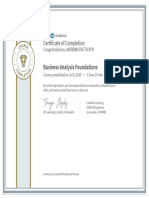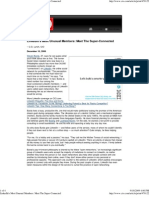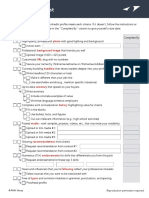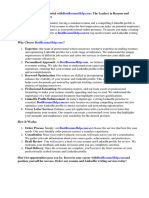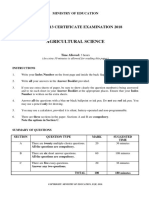18/5/23, 12:24 Data Science Process & Methodology | LinkedIn
Probar P
Inicio Mi red Empleos Mensajes Notificaciones Yo Para negocios
DataThick
AI & Data Insights
Newsletter diaria
11.583 suscriptores Suscrito
Data Science Process
Data Science Process &
Methodology
Pratibha Kumari J.
Digital Transformation Officer - Talk About 41 artículos Seguir
~~ Digital Strategy | Tech Startups | Data…
18 de mayo de 2023
DataThick | LinkedIn
DataThick | 3,898 followers on LinkedIn. Data
community for Data professionals and focus on
Data Insight & Artificial Intelligence. | DataThic…
in.linkedin.com
What is the Data Science Process?
The data science process is a systematic approach to
solving problems and extracting insights from data. It
typically involves the following steps:
Te has suscrito. Te avisaremos cuando haya un artículo nuevo. Los demás podrán ver que te has suscrito.
https://www.linkedin.com/pulse/data-science-process-methodology-pratibha-kumari-jha%3FtrackingId=gah5lCuQRzikj6RlMhXhpA%253D%253… 1/10
�18/5/23, 12:24 Data Science Process & Methodology | LinkedIn
Data Science Process
1. Problem Definition: Clearly define the problem or
question you want to address. Understand the
objectives, scope, and requirements of the project.
2. Data Collection: Gather relevant data from various
sources, such as databases, APIs, or external datasets.
Ensure the data is representative, comprehensive, and
meets the project requirements.
3. Data Understanding: Explore and analyze the collected
data to gain insights into its structure, quality, and
relationships. This involves tasks like data profiling,
visualization, and statistical analysis.
4. Data Preparation: Clean, preprocess, and transform the
data to make it suitable for analysis. Handle missing
values, outliers, and inconsistencies. Perform tasks like
data cleaning, feature selection, feature engineering,
and data normalization.
5. Model Development: Select an appropriate machine
learning or statistical model that aligns with the
problem and the available data. Train and optimize the
model using suitable algorithms, techniques, and
parameters.
6. Model Evaluation: Assess the performance and
effectiveness of the model. Use evaluation metrics and
techniques such as cross-validation, hypothesis testing,
or hold-out validation to measure the model's
accuracy, precision, recall, or other relevant metrics.
7. Model Deployment: Apply the trained model to new,
unseen data for making predictions or generating
insights. Integrate the model into a production system
Te has suscrito. Te avisaremos cuando haya un artículo nuevo. Los demás podrán ver que te has suscrito.
https://www.linkedin.com/pulse/data-science-process-methodology-pratibha-kumari-jha%3FtrackingId=gah5lCuQRzikj6RlMhXhpA%253D%253… 2/10
�18/5/23, 12:24 Data Science Process & Methodology | LinkedIn
or create a user-friendly interface to utilize the model's
results effectively.
8. Model Monitoring and Maintenance: Continuously
monitor the model's performance in real-world
scenarios. Track the model's predictions and assess its
accuracy and reliability over time. Make updates or
retrain the model as needed to ensure its effectiveness.
9. Communication and Visualization: Summarize and
communicate the findings, insights, and
recommendations derived from the data analysis
process. Use visualizations, reports, and presentations
to effectively communicate the results to stakeholders.
10. Iteration and Improvement: Iterate on the entire
process by incorporating feedback, new data, or new
requirements. Continuously refine and improve the
models, techniques, and methodologies used.
It's important to note that the data science process is not
necessarily linear and may involve iterations and
backtracking. Additionally, effective collaboration,
documentation, and ethical considerations play a crucial
role throughout the entire process.
Data Science Methodology
Data science methodology refers to a systematic approach
or framework for conducting data science projects. It
typically involves a series of steps or phases that guide the
entire data science lifecycle, from problem formulation to
the deployment of solutions. While different organizations
and practitioners may adopt variations of the methodology,
a commonly used framework includes the following steps:
1. Problem Definition: Clearly define the business
problem or objective that the data science project aims to
address. Understand the project scope, stakeholders, and
constraints.
· Example: A retail company wants to reduce customer
churn (the rate at which customers stop using their
services). The objective is to develop a predictive model
that identifies customers at high risk of churning so that
targeted retention strategies can be implemented.
Te has suscrito. Te avisaremos cuando haya un artículo nuevo. Los demás podrán ver que te has suscrito.
https://www.linkedin.com/pulse/data-science-process-methodology-pratibha-kumari-jha%3FtrackingId=gah5lCuQRzikj6RlMhXhpA%253D%253… 3/10
�18/5/23, 12:24 Data Science Process & Methodology | LinkedIn
2. Data Collection: Identify and gather relevant data from
various sources, such as databases, APIs, or external
datasets. Ensure data quality and consider privacy and
ethical considerations.
· Example: A retail company wants to reduce customer
churn (the rate at which customers stop using their
services). The objective is to develop a predictive model
that identifies customers at high risk of churning so that
targeted retention strategies can be implemented.
3. Data Preparation: Clean, preprocess, and transform the
collected data to make it suitable for analysis. This step
involves tasks such as data cleaning, handling missing
values, and feature engineering.
· Example: The retail company cleans the data by
removing duplicate records, imputes missing values, scales
numerical features, and converts categorical variables into
numerical representations using techniques like one-hot
encoding.
4. Exploratory Data Analysis (EDA): Explore the data to
gain insights, discover patterns, and identify relationships
between variables. Use visualizations and statistical
techniques to understand the data's characteristics.
· Example: The retail company performs EDA by analyzing
customer churn rates across different demographic
segments, examining correlations between purchase
frequency and customer satisfaction ratings, and visualizing
customer behavior patterns through cohort analysis.
5. Model Building: Select an appropriate machine
learning or statistical model that aligns with the problem
statement. Split the data into training and testing sets and
train the model using the training data.
· Example: The retail company chooses a classification
algorithm like logistic regression or random forest to build
a churn prediction model. They divide the data into a
training set (70% of the data) and a testing set (30% of the
data). The model is trained using the training set.
Te has suscrito. Te avisaremos cuando haya un artículo nuevo. Los demás podrán ver que te has suscrito.
https://www.linkedin.com/pulse/data-science-process-methodology-pratibha-kumari-jha%3FtrackingId=gah5lCuQRzikj6RlMhXhpA%253D%253… 4/10
�18/5/23, 12:24 Data Science Process & Methodology | LinkedIn
6. Model Evaluation: Assess the performance of the trained
model using appropriate evaluation metrics. Validate the
model against the testing data to measure its accuracy and
generalization capability.
· Example: The retail company evaluates the churn
prediction model by calculating metrics such as accuracy,
precision, recall, and F1 score using the testing data. They
assess how well the model identifies churned customers
compared to actual churned customers.
7. Model Deployment: Implement the model into a
production environment, making it accessible for real-time
predictions or decision-making. Integrate the model with
existing systems and ensure its scalability and reliability.
· Example: The retail company deploys the churn
prediction model into their customer relationship
management (CRM) system. The model is integrated into
the system's workflow, allowing the system to generate
churn risk scores for individual customers in real-time.
8. Model Monitoring and Maintenance: Continuously
monitor the deployed model's performance and address
any issues or concept drift that may arise. Update the
model periodically and refine it based on new data or
feedback.
· Example: The retail company regularly monitors the
churn prediction model's performance by tracking key
metrics such as accuracy and false positive rate. They
analyze the model's predictions over time and update it as
new data becomes available to maintain its accuracy and
relevance.
Throughout the entire methodology, it is crucial to maintain
open communication with stakeholders, document the
processes and decisions made, and iterate as necessary to
achieve the desired outcomes.
Data Science Project structure
Te has suscrito. Te avisaremos cuando haya un artículo nuevo. Los demás podrán ver que te has suscrito.
https://www.linkedin.com/pulse/data-science-process-methodology-pratibha-kumari-jha%3FtrackingId=gah5lCuQRzikj6RlMhXhpA%253D%253… 5/10
�18/5/23, 12:24 Data Science Process & Methodology | LinkedIn
A typical structure for a data science project includes the
following components:
Introduction:
Clearly define the problem statement and the goal of
the project.
Provide background information and context.
Introduction
Introduction
Data Collection and Understanding:
Describe the data sources and how the data was
obtained.
Perform exploratory data analysis (EDA) to understand
the structure, quality, and relationships within the data.
Document any data preprocessing or cleaning steps
taken.
Data Collection and Understanding:
Data Preparation and Feature Engineering:
Outline the steps taken to preprocess and transform
the data.
Discuss any feature engineering techniques applied to
enhance the predictive power of the model.
Te has suscrito. Te avisaremos cuando haya un artículo nuevo. Los demás podrán ver que te has suscrito.
https://www.linkedin.com/pulse/data-science-process-methodology-pratibha-kumari-jha%3FtrackingId=gah5lCuQRzikj6RlMhXhpA%253D%253… 6/10
�18/5/23, 12:24 Data Science Process & Methodology | LinkedIn
Data Preparation and Feature Engineering
Model Development and Evaluation:
Describe the machine learning or statistical models
considered and selected for the project.
Explain the methodology used for model training,
validation, and evaluation.
Present the results and performance metrics of the
models.
Model Development and Evaluation
Model Deployment:
Explain how the trained model will be deployed or
utilized in practice.
Discuss any implementation considerations or
integration with existing systems.
Model Deployment
Model Monitoring and Maintenance:
Te has suscrito. Te avisaremos cuando haya un artículo nuevo. Los demás podrán ver que te has suscrito.
https://www.linkedin.com/pulse/data-science-process-methodology-pratibha-kumari-jha%3FtrackingId=gah5lCuQRzikj6RlMhXhpA%253D%253… 7/10
�18/5/23, 12:24 Data Science Process & Methodology | LinkedIn
Outline the steps for monitoring the model's
performance in real-world scenarios.
Describe any plans for updating or retraining the
model as needed.
Model Monitoring and Maintenance
Conclusion:
Summarize the key findings and insights from the
project.
Discuss the limitations and potential future
improvements.
Conclusion
Documentation and Code:
Documentation and Code
Provide documentation for the project, including
details about the data, methods, and assumptions
made.
Include code scripts or notebooks used for data
Te has suscrito. Te avisaremos cuando hayapreprocessing, model
un artículo nuevo. Los development,
demás podrán ver que te hasand evaluation.
suscrito.
https://www.linkedin.com/pulse/data-science-process-methodology-pratibha-kumari-jha%3FtrackingId=gah5lCuQRzikj6RlMhXhpA%253D%253… 8/10
�18/5/23, 12:24 Data Science Process & Methodology | LinkedIn
It's important to note that the structure may vary
depending on the specific project, organization, or industry
requirements. It's always a good practice to maintain clear
and organized documentation throughout the project to
ensure reproducibility and facilitate collaboration.
#datascience #machinelearning #python
#artificialintelligence #ai #data #dataanalytics #bigdata
#programming #coding #datascientist #technology
#deeplearning #computerscience #datavisualization
#analytics #pythonprogramming #tech #iot #dataanalysis
#java #developer #programmer #business #ml #database
#software #javascript #statistics #innovation #datathick
DataThick | LinkedIn
DataThick | 3,898 followers on LinkedIn. Data
community for Data professionals and focus on
Data Insight & Artificial Intelligence. | DataThic…
in.linkedin.com
Denunciar esto
Publicado por
Pratibha Kumari J. 41 Seguir
Digital Transformation Officer - Talk About ~~ Digital
artículos
Strategy | Tech Startups | Data Science, Machine Learning, BI
& Big Data Analytics, AI & Data Community
Fecha de publicación: 3 horas
The data science process is a systematic approach to solving problems and extracting
insights from data.
Recomendar Comentar Compartir
37 2 comentarios
Reacciones
+25
2 comentarios
Más relevantes
Añadir un comentario…
CHESTER SWANSON SR. • +3er 1 hora
Exp Realty LLC. / Har.com/Chester-Swanson/agent_cbswan
Thanks for sharing.
Ver traducción
Recomendar · 1 Responder
Emmanuel Olasupo • +3er 2 horas
Te has suscrito. Te avisaremos cuando haya unData
artículo
analystnuevo. Los demás podrán ver que te has suscrito.
https://www.linkedin.com/pulse/data-science-process-methodology-pratibha-kumari-jha%3FtrackingId=gah5lCuQRzikj6RlMhXhpA%253D%253… 9/10
�18/5/23, 12:24 Data Science Process & Methodology | LinkedIn
Thank you for this
Ver traducción
Recomendar Responder
DataThick
AI & Data Insights
11.583 suscriptores
Suscrito
Más de esta newsletter
Machine Learning Libraries What is Generative AI &
Influence of Generative AI
Pratibha Kumari J. en LinkedIn
Pratibha Kumari J. en LinkedIn
Artificial Intelligence (AI)
stack
Pratibha Kumari J. en LinkedIn
Te has suscrito. Te avisaremos cuando haya un artículo nuevo. Los demás podrán ver que te has suscrito.
https://www.linkedin.com/pulse/data-science-process-methodology-pratibha-kumari-jha%3FtrackingId=gah5lCuQRzikj6RlMhXhpA%253D%253… 10/10





























